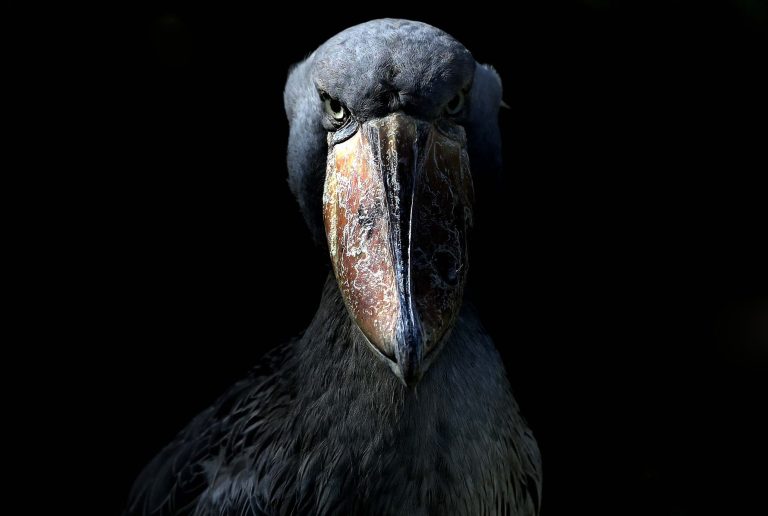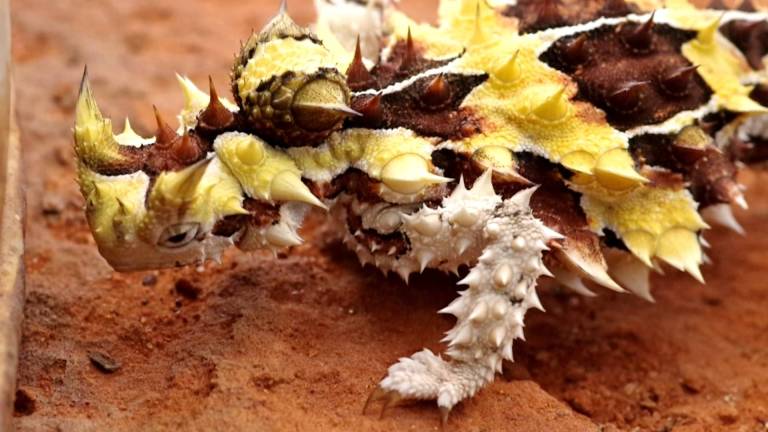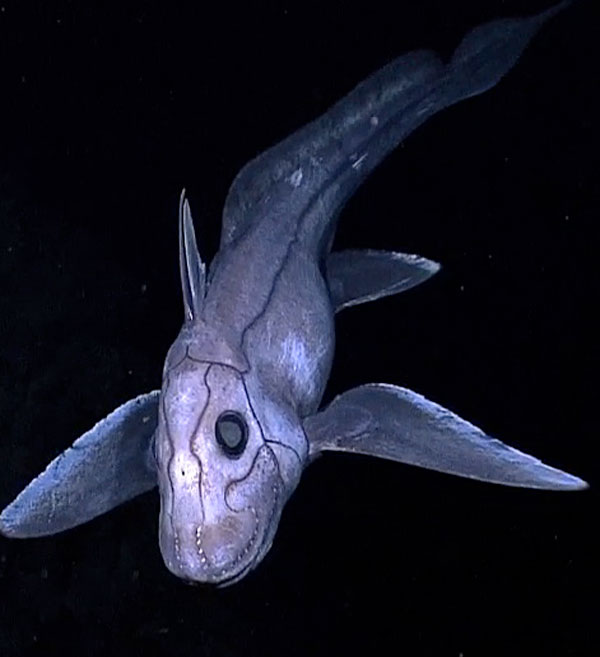10. Yangtze Giant Softshell Turtle

The Yangtze giant softshell turtle (Rafetus swinhoei) is an extremely rare species of softshell turtle found in China. It is also known as the Red River giant softshell turtle, Shanghai softshell turtle, or Swinhoe’s softshell turtle. In Chinese, it is known as the speckled softshell turtle (Chinese: 斑鱉; Pinyin: bān bīe). Only three living individuals are known (a fourth being reported dead in January 2016), and it is listed as extinct in the wild in the IUCN Red List. It is hoped that a pair at Suzhou Zoo in China will breed.
The Yangtze giant softshell turtle is noted for its deep head with a pig-like snout and dorsally placed eyes. This critically endangered species holds the title of being the largest freshwater turtle in the world.[3] It measures over 100 cm (39 in) in overall length and to 70 cm (28 in) in width, and can easily weigh up to 70–100 kg (150–220 lb).[4]
9. Shoebill

The shoebill (Balaeniceps rex) also known as whalehead or shoe-billed stork, is a very large stork-like bird. It derives its name from its massive shoe-shaped bill. Although it has a somewhat stork-like overall form and has previously been classified in the order Ciconiiformes, its true affiliations with other living birds is ambiguous. Some authorities now reclassify it with the Pelecaniformes. The adult is mainly grey while the juveniles are browner. It lives in tropical east Africa in large swamps from Sudan to Zambia.[2]
The shoebill is a tall bird, with a typical height range of 110 to 140 cm (43 to 55 in) and some specimens reaching as much as 152 cm (60 in). Length from tail to beak can range from 100 to 140 cm (39 to 55 in) and wingspan is 230 to 260 cm (7 ft 7 in to 8 ft 6 in). Weight has reportedly ranged from 4 to 7 kg (8.8 to 15.4 lb).[7][8]
8.Lowland Streaked Tenrec

The lowland streaked tenrec (Hemicentetes semispinosus) is a small tenrec found in Madagascar. If threatened by a predator (most commonly a fossa or Malagasy mongoose), a streaked tenrec erects the barbed quills on its back and on the crest around its head, pointing them completely forward, and drives them in to the attacker’s nose or paws with body and head movements. The nonbarbed quills are clustered in the middle of the back, and produce a faint chattering sound when vibrated, and are used to communicate within family groups.
7. Angel Shark

Squatina is a genus of shark in the family Squatinidae, which are unusual in having flattened bodies and broad pectoral fins that give them a strong resemblance to rays. This genus is the only one in its family and order Squatiniformes. They occur worldwide in temperate and tropical seas. Most species inhabit shallow temperate or tropical seas, but a few species inhabits deeper water, down to 1,300 m (4,300 ft).[2] Angel sharks are sometimes called monkfish, although this name is also applied to members of the genus Lophius.
While the forward part of the angel shark’s body is broad and flattened, the rear part retains a muscular appearance more typical of other sharks. The eyes and spiracles are on top and the five gill slits are on its back. Both the pectorals and the pelvic fins are large and held horizontally. There are two dorsal fins, no anal fin and unusually for sharks, the lower lobe of the caudal fin is longer than the upper lobe. Most types grow to a length of 1.5 m (5 ft), with the Japanese angel shark, known to reach 2 m.[3] Angel sharks possess extensible jaws that can rapidly snap upwards to capture prey and have long, needle-like teeth. They bury themselves in sand or mud lying in wait for prey, which includes fish, crustaceans and various types of mollusks.[2]
6. Thorny Dragon

The thorny dragon or thorny devil (Moloch horridus) is an Australian Lizard, also known as the mountain devil, the thorny lizard, or the moloch. This is the sole species of genus Moloch. The thorny dragon grows up to 20 cm (7.9 in) in length, and it can live for up to 20 years. Most of these lizards are coloured in camouflaging shades of desert browns and tans. These colours change from pale colours during warm weather and to darker colours during cold weather. These animals are covered entirely with conical spines that are mostly uncalcified.
The thorny dragon also features a spiny “false head” on the back of its neck, and the lizard presents this to potential predators by dipping its real head.
5. Gerenuk

The gerenuk Somali: garanuug (pronounced /\ˈger-ə-ˌnu̇k, gə-ˈre-nək\/) (Litocranius walleri), also known as the giraffe gazelle, is a long-necked antelope found in the Horn of Africa and the African Great Lakes region. The sole member of the genus Litocranius, the gerenuk was first described by Anglo-Irish naturalist Victor Brooke in 1878. It is characterised by its long, slender neck and limbs. The antelope is 80–105 centimetres (31–41 in) tall, and weighs between 28 and 52 kilograms (62 and 115 lb). Two types of colouration are clearly visible on the smooth coat: the reddish brown back or the “saddle”, and the lighter flanks, fawn to buff. The horns, present only on males, are lyre-shaped. Curving backward then slightly forward, these measure 25–44 centimetres (9.8–17.3 in).
4. Marine Hatchetfish

Marine hatchetfishes or deep-sea hatchetfishes are small deep-sea mesopelagic ray-finned fish of the stomiiform subfamily Sternoptychinae. They should not be confused with the freshwater hatchetfishes, which are not particularly closely related Teleostei in the characiform family Gasteropelecidae.[1]
Found in tropical, subtropical and temperate waters of the Atlantic, Pacific and Indian Oceans, marine hatchetfishes range in size from Polyipnus danae at 2.8 cm (1.1 in) to the c.12 cm (4.7 in)-long Giant hatchetfish(Argyropelecus gigas). They are small deep-sea fishes which have evolved a peculiar body shape and like their relatives have bioluminescent photophores. The latter allow them to use counter-illumination to escapepredators that lurk in the depths: by matching the light intensity with the light penetrating the water from above, the fish does not appear darker if seen from below. They typically occur at a few hundred meters below the surface, but their entire depth range spans from 50 to 1,500 meters deep.[1][5]
3. Chimaeras

Chimaeras[1] are cartilaginous fishes in the order Chimaeriformes, known informally as ghost sharks, rat fish (not to be confused with the rattails), spookfish (not to be confused with the true spookfish of the familyOpisthoproctidae), or rabbit fish (not to be confused with the true rabbitfishes of the family Siganidae).
At one time, a “diverse and abundant” group (based on the fossil record), their closest living relatives are sharks, though in evolutionary terms, they branched off from sharks nearly 400 million years ago and have remained isolated ever since.[2] Today, they are largely confined to deep water.[3]
Chimaeras live in temperate ocean floors down to 2,600 m (8,500 ft) deep, with few occurring at depths shallower than 200 m (660 ft). Exceptions include the members of the genus Callorhinchus, the rabbit fish and the spotted ratfish, which locally or periodically can be found at relatively shallow depths. Consequently, these are also among the few species from the Chimaera order kept in public aquaria.[4] They have elongated, soft bodies, with a bulky head and a single gill-opening. They grow up to 150 cm (4.9 ft) in length, although this includes the lengthy tail found in some species. In many species, the snout is modified into an elongated sensory organ.[5]
2. Glaucus Atlanticus

Glaucus atlanticus (common names include the sea swallow, blue angel, blue glaucus, blue dragon, blue sea slug and blue ocean slug) is a species of small, blue sea slug, a pelagic aeolid nudibranch, a shell-lessgastropod mollusk in the family Glaucidae.[1]
These sea slugs are pelagic: they float upside down by using the surface tension of the water to stay up, where they are carried along by the winds and ocean currents. Glaucus atlanticus is camouflaged: the blue side of their body faces upwards, blending in with the blue of the water. The silver/grey side of the sea slugs faces downwards, blending in with the silvery surface of the sea.
Glaucus atlanticus feeds on other pelagic creatures, including the venomous siphonophore, the Portuguese man o’ war. This sea slug stores stinging nematocysts from the cnidarian within its own tissues as defense against predation. Humans handling the slug may receive a very painful and potentially dangerous sting.
1. Axolotl

The axolotl (/ˈæksəlɒtəl/, from Classical Nahuatl: āxōlōtl [aː.ˈʃóː.loːtɬ]) also known as a Mexican salamander (Ambystoma mexicanum) or a Mexican walking fish, is a neotenic salamander, closely related to the tiger salamander.[2][3] Although the axolotl is colloquially known as a “walking fish“, it is not a fish, but an amphibian. The species originates from numerous lakes, such as Lake Xochimilco underlying Mexico City.[4] Axolotls are unusual among amphibians in that they reach adulthood without undergoing metamorphosis. Instead of developing lungs and taking to land, the adults remain aquatic and gilled.
The feature of the salamander that attracts most attention is its healing ability: the axolotl does not heal by scarring and is capable of the regeneration of entire lost appendages in a period of months, and, in certain cases, more vital structures. Some have indeed been found restoring the less vital parts of their brains. They can also readily accept transplants from other individuals, including eyes and parts of the brain—restoring these alien organs to full functionality. In some cases, axolotls have been known to repair a damaged limb, as well as regenerating an additional one, ending up with an extra appendage that makes them attractive to pet owners as a novelty. In metamorphosed individuals, however, the ability to regenerate is greatly diminished. The axolotl is therefore used as a model for the development of limbs in vertebrates.[17]

Another great amazing post:) Really didnt know such mysterious animals.
Join my website as well http://listentoyouropinion.com I’m intrested in your opinion
LikeLiked by 1 person
Thanks Yaroslov. The world is an amazing place full of discoveries yet to be made. It’s fun to learn about these fascinating creatures. +1 to your website; a lot of great topics!
LikeLike